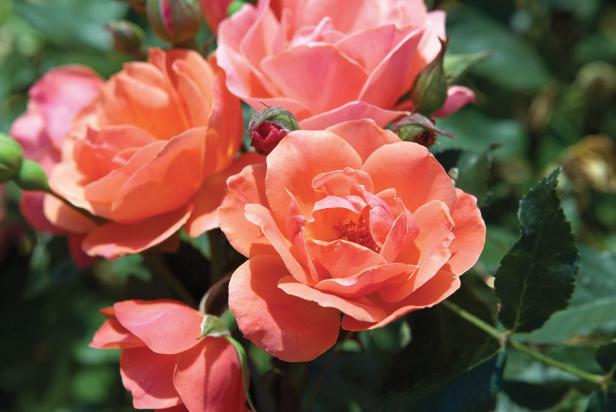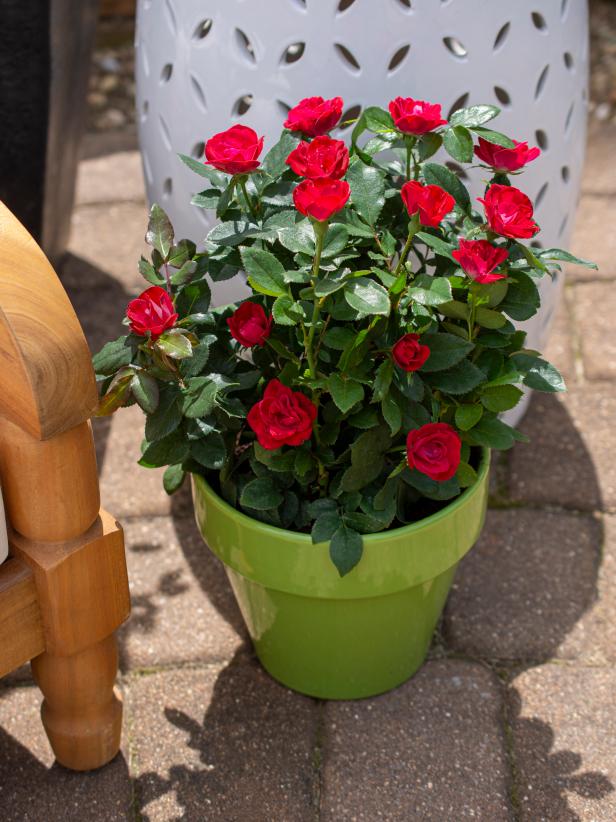How to Grow Knock Out Roses
Roses are garden divas, but easy-to-grow Knock Out roses put roses within the skill set of most gardeners.

Knock Out roses are one of the best-selling landscape plants in the country, and they have been since their introduction a generation ago.

Star Roses & Plants
Knock Out roses can serve as foundation plantings, border plants, low hedges, or even specimen plants in your landscape.
They're popular because they're one of the longest blooming, lowest-maintenance, most pest- and disease-resistant roses out there. Knock Out roses are even resistant to black spot disease, the scourge of rose growers. If you've ever had a rose bush die on you — and who hasn't? — black spot was probably the culprit.
Roses are notoriously difficult to grow. They're garden divas that require pruning, spraying, feeding and constant attention. But Knock Outs have put roses within the skill set of most gardeners. You don't even have to deadhead the things; they just drop their own flowers and keep on blooming.
"Knock Out doesn't know it's a rose," Bill Radler, the rose breeder who developed the variety, told Wisconsin PBS in 2001, a year after his creation hit the market.
The instant success of the easy-care, disease-resistant roses led to development of a family of Knock Out roses, including the compact Petite Knock Out that grows just 18 inches high with flower size averaging 1 1/2 inches in diameter, the Double Knock Out, and Knock Outs that bloom in a range of colors including coral, yellow, pink and white.

Star Roses & Plants
The Coral Knock Out rose grows to an average height and width of 4 1/2 feet.
These days you can't swing a pair of pruners at a plant nursery without hitting a pallet of Knock Out roses. Here's what you need to know to grow them and ideas on how to use them to add color to your yard, patio and garden.
Botanical Name: Rosa Radrazz
Common Name: Knock Out Rose
Bloom Time: Spring through Fall
Hardiness Zones: USDA Zones 4 to 9
Planting Knock Out Roses
Plant Knock Outs in spring or fall. They'll have less risk of transplant shock when the temps are mild.
Pick a spot where your Knock Out roses will get 6 to 8 hours of sun per day. They can tolerate some shade but they bloom best in full sun.
Space them at least 3 feet apart. This makes room for them to reach their mature size and still have good air circulation, which is key to disease prevention.
Caring for Knock Out Roses
Low maintenance doesn't mean no maintenance. Here's how to keep your Knock Outs looking knock-out gorgeous.
Knock Outs do best in neutral soil with a pH between 5.5 and 6.5. You can amend your soil to raise or lower the pH as needed. There are at-home soil pH testing kits available, or your local extension office should be able to analyze a soil sample for you.
Water regularly during the summer growing season. How much water you give your rose depends on where you live and how much rainfall you get. They're not thirsty plants and are drought tolerant, but they still need a couple of gallons of water a week during the growing season.
Fertilize them monthly or bi-monthly during the growing season. Use a balanced rose food. Stop fertilizing in late summer so the plant will put its energy into its roots to get ready for winter.
When to Trim Knockout Roses
Prune your roses in late winter/early spring, when new shoots emerge from the canes. Do a hard trim, removing 2/3 of the shrub, every two or three years.
You don't need to deadhead them. As we said earlier, Knock Outs bloom even if you don't trim off the spent blooms, so they're the lazy gardener's friend. Deadheading makes them look tidier, though.
Growing Knock Out Roses in Containers
Yes, you can grow Knock Out roses in a pot. Pick a container with good drainage that is two sizes larger than the pot the rose comes in. This gives it room to grow. Water twice weekly during the growing season. Depending on where you live, you may need to move the potted rose indoors in the winter, because its root system will be more likely to freeze in a container. In places with very cold winters, bring the roses inside and store them in a cool, dark area such as your basement or garage.

Star Roses and Plants
Mature Petite Knock Out rose plants are 18 inches tall and work well in decorative containers. Flower size is about 1 1/2 inches in diameter.
Using Knock Out Roses in the Landscape
Knock Out roses can be the utility infielders of your landscape. They can be foundation plantings, border plants, low hedges, or even specimen plants. You can plant them in containers, too. Because they bloom continually for nine months, they bring color to the landscape in late summer when other flowers are spent.
Hedge
Plant Knock Out roses in a mass planting of the same color to make a striking hedge that's covered in blooms spring through fall. Line a driveway, a walkway or define the perimeter of your garden with an explosion of colorful roses. Space them 3 feet apart to give them room to reach their mature size and allow for air circulation. Prune them in the early spring to the height you want.
Foundation planting
If you want a variant on the usual boxwoods or other evergreen shrubs, use Knock Outs as foundation plantings around your house. You'll have a mass of roses for most of the year surrounding your house. The bloom colors will pop out against dark houses. Put a row of short boxwoods in front of the Knock Out roses to define the perimeter of the bed and add a formal row of green to the soft mounds of colorful roses.
Containers
You can plant Knock Outs in containers, a good solution if your yard is mostly shade because you can move the pot where the sun is. Put potted Knock Out roses in matching pots on either side of your front steps or put a single potted Knock Out on a sunny patio for a pop of color. Plant one of the two varieties of Knock Outs with a scent — The Sunny Knock Out Rose and The White Knock Out — in pots and place by your front door so you get a waft of fragrance when you walk in or out of your house.
Use them as the thriller plant in a thriller/spiller/filler container recipe, mixing them with fillers like Artemisia, dianthus, coral bells, or bacopa and spillers like licorice plant, Blue Star creeper, Calibrachoa and sweet potato vine.
Specimen Plant
Some Knock Outs get up to 7 feet tall, so they can bring height to a flower garden when used as a solitary specimen plant. Place a Knock Out rose in a circular bed and surround it with low, mounding foliage plants. Or use a Knock Out rose in a cottage garden along with coneflowers, Shasta daisies and delphinium to add a touch of formality.
Borders
Knock Out roses can tolerate some shade, so they're a good pick for a naturalized border between a yard and an adjacent woodland. They can also be used in the middle or back of a mixed, sunny border, where they'll provide color in the late summer and early fall when other flowers are done blooming for the year.
Knock Out Rose Varieties 16 Photos
Knock Out roses are among the most popular landscaping plants in America. You may be familiar with the original, single-petal Knock Out rose. Meet the rest of the Knock Out Rose family and get some tips on using them in your landscape.
Pests and Diseases
Knock Out roses are famously resistant to bugs and rose diseases. But they are susceptible to rose rosette, a virus spread by eriophyid mites that blow in on the wind. The tiny mites eat a rose, give the plant the virus, and boom, your Knock Out is sick. Once infected, your formerly healthy rose will begin producing bunches of bright red new shoots that look, well, weird. Those shoots bloom, but the roses are distorted. As the rose rosette virus spreads through the plant, the plant slowly dies back until it completely dies.
Like all plant viruses, rose rosette is tough to control because it spreads internally to every part of the plant. Pruning off those bright red shoots as soon as they appear, being sure to cut through the healthy green wood below, may save the rose. But once the entire plant gets full-blown rose rosette, the plant is finished. Spraying won't work. Pull the plant out by the roots, bag it up, and throw it in the trash (not the composter!) so it won't infect surrounding plants.
They can also get Japanese beetles and rose slugs (also called sawfly) but the roses are so tough that even if bugs munch on their leaves, they'll survive.














































